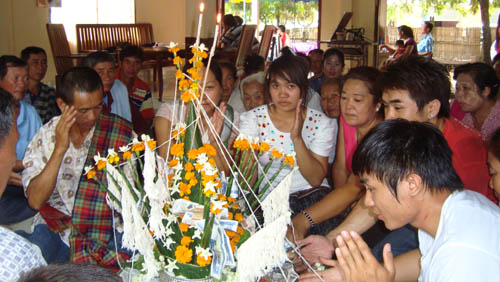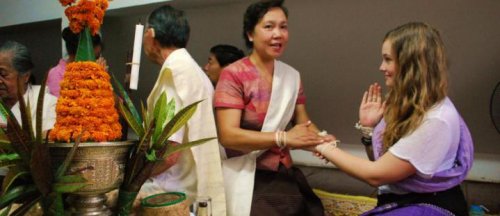Baci Ritual: A Centrepiece Of Lao Culture
The baci or Sou khuan is a well-known traditional ritual and has its origins in the ancient customs of past generations.
This ceremony has a deep meaning for Lao people, as well as for visitors to the country. A baci ceremony is an important part of Lao culture.
The baci ceremony is reminiscent of Brahmanism and animism. It follows the belief that the human being’s main body parts are inhabited by 32, or even more, spirits. In some circumstances, these spirits may leave the body to wander around and get lost in the universe, thus causing you to become weak and vulnerable to danger.
It’s therefore important to call the missing spirits back, so you can be yourself again. This ceremony is performed on important occasions such as births, weddings, farewells, visits, convalescence, and death. In the latter two cases, it comforts members of the family of the ill or dead.
Lao people often hold a baci ceremony to call upon the spirits when someone is physically weak. When a family member is sick, older people will hold a baci to call the spirits back home as they believe illness is caused by the soul’s guardian spirits going astray.
A baci may also be held to call upon the spirits to protect a person travelling to another country. Other reasons for holding the ceremony include the need to bring luck and prosperity, and success in a professional field.

The baci ceremony is most common during April’s Pi Mai Lao (Lao New Year) festival, when you will often see people holding a baci in their home or office to bestow good luck and success in the coming year.
Participants sit on the floor around a plate of flowers, sweets, a cooked chicken, boiled eggs, a basket of sticky rice, and locally brewed alcohol, collectively known as the pha khuan . Most of the time a mor phon (a respected and knowledgeable member of the community) starts the ceremony and calls upon the spirits to return. Then participants tie a white thread around one another’s wrists while wishing each person good luck.
Also threaded through the pha khuan are long white strings. They’re held by participants to connect them to those seated closest to the pha khuan, so they too are fully blessed.
People gather and sit on a mat around the ceremonial centrepiece, ensuring they avoid pointing their feet towards it and the other participants. Women are expected to wear a traditional silk skirt (sinh) and blouse, while men also dress conservatively.
The mor phon takes the white thread connected to the pha khuan and places one end in the host’s hand and the other in the hand of the person who is to receive blessings. They hold the string between their palms as they pray with the mor phon, while he invokes the spirits to bring good luck and success. The mor phon closes his eyes and chants in the religious Pali language and sometimes quotes from Lao poetry and proverbs. At a wedding, traditional stories advise the couple about what is expected from a good husband and wife. The ceremony varies in length from 30 minutes to an hour.
During the ceremony, family and friends say together “Khuan Euy Ma Yer”, meaning “Please Come, Spirits Come”. Participants then throw milled rice over one another as a symbol of the good luck they have asked for. After the ceremony, the mor phon ties the first white blessing thread around the wrists of the main person being honoured. Everyone joins in to tie thread around the wrists of the main celebrant and other people present, while murmuring their best wishes for a happy life.
Some people roll up money and tie it inside a white thread which they give to the host. The tying of thread is said to bring luck in health, wealth, work and love. At the end of the ceremony, the mor phon tells participants to keep the white threads tied around their wrists if they want their wishes to come true. They have to wait for three days and be careful not to cut them, as the good wishes will be severed if a thread breaks.
After the ceremony, the host invites all the guests to eat, which is usually followed by dancing. The purpose of a baci is to build unity among families, friends and relatives. So stretch your legs, prepare your wishes, and discover this charming Lao custom.
published with the permission of Vientiane Times


